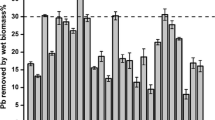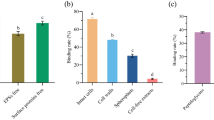Abstract
Di-(2-ethylhexyl) phthalate (DEHP) is the widely detected plasticizer in foods whose exposure is associated with a myriad of human disorders. The present study focused on identifying Lactobacillus strains with high adsorption potential towards DEHP and further elucidating the mechanism of binding using HPLC, FTIR and SEM. Two strains, Lactobacillus rhamnosus GG and Lactobacillus plantarum MTCC 25,433, were found to rapidly adsorb more than 85% of DEHP in 2 h. Binding potential remained unaffected by heat treatment. Moreover, acid pre-treatment enhanced the DEHP adsorption. Chemical pre-treatments, such as NaIO4, pronase E or lipase, caused reduction in DEHP adsorption to 46% (LGG), 49% (MTCC 25,433) and 62% (MTCC 25,433), respectively, attributing it to cell wall polysaccharides, proteins and lipids. This was also corroborated by stretching vibrations of C = O, N–H, C–N and C–O functional groups. Furthermore, SDS and urea pre-treatment, demonstrated the crucial role of hydrophobic interactions in DEHP adsorption. The extracted peptidoglycan from LGG and MTCC 25,433 adsorbed 45% and 68% of DEHP, respectively, revealing the imperative role of peptidoglycan and its integrity in DEHP adsorption. These findings indicated that DEHP removal was based on physico-chemical adsorption and cell wall proteins, polysaccharides or peptidoglycan played a primary role in its adsorption. Owing to the high binding efficiency, L. rhamnosus GG and L. plantarum MTCC 25,433 were considered to be a potential detoxification strategy to mitigate the risk associated with the consumption of DEHP-contaminated foods.







Similar content being viewed by others
Data Availability
All data generated or analysed during this study are included in this published article.
References
Kashyap D, Agarwal T (2018) Concentration and factors affecting the distribution of phthalates in the air and dust: a global scenario. Sci Total Environ 635:817–827. https://doi.org/10.1016/j.scitotenv.2018.04.158
Duttagupta S, Mukherjee A, Bhattacharya A, Bhattacharya J (2020) Wide exposure of persistent organic pollutants (PoPs) in natural waters and sediments of the densely populated Western Bengal basin, India. Sci Total Environ 717:137187. https://doi.org/10.1016/j.scitotenv.2020.137187
Rozati R, Simha B, Bendi N, Sekhar C (2008) Evaluation of the phthalate esters in South Indian women with endometriosis. Int J Fertil Steril 1:165–170. https://doi.org/10.22074/IJFS.2007.46210
Kim SH, Cho SH, Ihm HJ et al (2015) Possible role of phthalate in the pathogenesis of endometriosis: in vitro, animal, and human data. J Clin Endocrinol Metab 100:E1502–E1511. https://doi.org/10.1210/jc.2015-2478
Pednekar PP, Gajbhiye RK, Patil AD et al (2018) Estimation of plasma levels of bisphenol-a & phthalates in fertile & infertile women by gas chromatography-mass spectrometry. Indian J Med Res 148:734–742. https://doi.org/10.4103/ijmr.IJMR_2077_16
Koliada A, Syzenko G, Moseiko V et al (2017) Association between body mass index and Firmicutes/Bacteroidetes ratio in an adult Ukrainian population. BMC Microbiol 17:120. https://doi.org/10.1186/s12866-017-1027-1
Vafeiadi M, Myridakis A, Roumeliotaki T et al (2018) Association of early life exposure to phthalates with obesity and cardiometabolic traits in childhood: sex specific associations. Front Public Heal 6:327. https://doi.org/10.3389/fpubh.2018.00327
Ponsonby AL, Symeonides C, Saffery R et al (2020) Prenatal phthalate exposure, oxidative stress-related genetic vulnerability and early life neurodevelopment: a birth cohort study. Neurotoxicology 80:20–28. https://doi.org/10.1016/j.neuro.2020.05.006
Serrano SE, Braun J, Trasande L et al (2014) Phthalates and diet: a review of the food monitoring and epidemiology data. Environ Heal 13:43. https://doi.org/10.1186/1476-069X-13-43
Cirillo T, Latini G, Castaldi MA et al (2015) Exposure to di-2-ethylhexyl phthalate, di-n-butyl phthalate and bisphenol A through infant formulas. J Agric Food Chem 63:3303–3310. https://doi.org/10.1021/JF505563K
Kıralan SS, Toptancı İ, Öncül Abacıgil T, Ramadan MF (2020) Phthalates levels in olive oils and olive pomace oils marketed in Turkey. Food Addit Contam - Part A Chem Anal Control Expo Risk Assess 37:1332–1338. https://doi.org/10.1080/19440049.2020.1766120
Akhbarizadeh R, Russo G, Rossi S et al (2021) Emerging endocrine disruptors in two edible fish from the Persian Gulf: occurrence, congener profile, and human health risk assessment. Mar Pollut Bull 166:112241. https://doi.org/10.1016/j.marpolbul.2021.112241
Chakraborty P, Bharat GK, Gaonkar O et al (2022) Endocrine-disrupting chemicals used as common plastic additives: levels, profiles, and human dietary exposure from the Indian food basket. Sci Total Environ 810:152200. https://doi.org/10.1016/j.scitotenv.2021.152200
Zota AR, Phillips CA, Mitro SD (2016) Recent fast food consumption and bisphenol A and phthalates exposures among the U.S. population in NHANES, 2003–2010. Environ Health Perspect 124:1521–1528. https://doi.org/10.1289/ehp.1510803
Edwards L, McCray NL, VanNoy BN et al (2022) Phthalate and novel plasticizer concentrations in food items from U.S. fast food chains: a preliminary analysis. J Expo Sci Environ Epidemiol 32:366–373. https://doi.org/10.1038/s41370-021-00392-8
Silano V, Barat Baviera JM, Bolognesi C et al (2019) Update of the risk assessment of di-butylphthalate (DBP), butyl-benzyl-phthalate (BBP), bis(2-ethylhexyl)phthalate (DEHP), di-isononylphthalate (DINP) and di-isodecylphthalate (DIDP) for use in food contact materials. EFSA J 17:e05838. https://doi.org/10.2903/j.efsa.2019.5838
Lee C-Y, Suk F-M, Twu Y-C, Liao Y-J (2020) Long-term exposure to low-dose di-(2-ethylhexyl) phthalate impairs cholesterol metabolism in hepatic stellate cells and exacerbates liver fibrosis. Int J Environ Res Public Health 17:3802. https://doi.org/10.3390/ijerph17113802
García-Fabila MM, Chávez AA, Meza JCS et al (2020) Phthalates in the diet of Mexican children of school age. Risk analysis Toxicol Reports 7:1487. https://doi.org/10.1016/J.TOXREP.2020.10.020
Das MT, Ghosh P, Thakur IS (2014) Intake estimates of phthalate esters for South Delhi population based on exposure media assessment. Environ Pollut 189:118–125. https://doi.org/10.1016/j.envpol.2014.02.021
Gao HT, Xu R, Cao WX et al (2017) Effects of six priority controlled phthalate esters with long-term low-dose integrated exposure on male reproductive toxicity in rats. Food Chem Toxicol 101:94–104. https://doi.org/10.1016/J.FCT.2017.01.011
Pradeep S, Sarath Josh MK, Binod P et al (2015) Achromobacter denitrificans strain SP1 efficiently remediates di(2-ethylhexyl)phthalate. Ecotoxicol Environ Saf 112:114–121. https://doi.org/10.1016/J.ECOENV.2014.10.035
Luo S, Li L, Chen A et al (2017) Biosorption of diethyl phthalate ester by living and nonliving Burkholderia cepacia and the role of its cell surface components. Chemosphere 178:187–196. https://doi.org/10.1016/j.chemosphere.2017.03.042
Lamraoui I, Eltoukhy A, Wang J et al (2020) Biodegradation of di (2-ethylhexyl) phthalate by a novel Enterobacter spp. strain YC-IL1 isolated from polluted soil, Mila, Algeria. Int J Environ Res Public Health 17:1–15. https://doi.org/10.3390/IJERPH17207501
Kamaraj Y, Jayathandar RS, Dhayalan S et al (2022) Biodegradation of di-(2-ethylhexyl) phthalate by novel Rhodococcus sp. PFS1 strain isolated from paddy field soil. Arch Microbiol 204:21. https://doi.org/10.1007/s00203-021-02632-9
Zhai Q, Tian F, Wang G et al (2016) The cadmium binding characteristics of a lactic acid bacterium in aqueous solutions and its application for removal of cadmium from fruit and vegetable juices. RSC Adv 6:5990–5998. https://doi.org/10.1039/c5ra24843d
Zoghi A, Khosravi-Darani K, Sohrabvandi S et al (2017) Effect of probiotics on patulin removal from synbiotic apple juice. J Sci Food Agric 97:2601–2609. https://doi.org/10.1002/jsfa.8082
Yousefi M, Shariatifar N, Tajabadi Ebrahimi M et al (2019) In vitro removal of polycyclic aromatic hydrocarbons by lactic acid bacteria. J Appl Microbiol 126:954–964. https://doi.org/10.1111/jam.14163
Zhao L, Li X, Yang Q et al (2020) Adsorption kinetics and mechanism of di-n-butyl phthalate by Leuconostoc mesenteroides. Food Sci Nutr 8:6153–6163. https://doi.org/10.1002/FSN3.1908
Fan YH, Shen YL, Lin ZW et al (2021) Key role of exopolysaccharide on di-butyl phthalate adsorbing by Lactobacillus plantarum CGMCC18980. Appl Microbiol Biotechnol 105:2587–2595. https://doi.org/10.1007/s00253-021-11145-w
Zhao L, Wei J, Pan X et al (2021) Critical analysis of peptidoglycan structure of Lactobacillus acidophilus for phthalate removal. Chemosphere 282:130982. https://doi.org/10.1016/j.chemosphere.2021.130982
Tian X, Yu Z, Feng P et al (2019) Lactobacillus plantarum TW1-1 alleviates diethylhexylphthalate-induced testicular damage in mice by modulating gut microbiota and decreasing inflammation. Front Cell Infect Microbiol 9:221. https://doi.org/10.3389/FCIMB.2019.00221/FULL
Chen Q, Kong Q, Tian P et al (2022) Lactic acid bacteria alleviate di-(2-ethylhexyl) phthalate-induced liver and testis toxicity via their bio-binding capacity, antioxidant capacity and regulation of the gut microbiota. Environ Pollut 305:119197. https://doi.org/10.1016/j.envpol.2022.119197
Shoukat S, Aslam MZ, Rehman A, Zhang B (2019) Screening of Bifidobacterium strains to bind with Benzo[a]pyrene under food stress factors and the mechanism of the process. J Food Process Preserv 43:1–8. https://doi.org/10.1111/jfpp.13956
Tallon R, Bressollier P, Urdaci MC (2003) Isolation and characterization of two exopolysaccharides produced by Lactobacillus plantarum EP56. Res Microbiol 154:705–712. https://doi.org/10.1016/J.RESMIC.2003.09.006
Saini SS (2018) Trace analysis of di-(2-ethylhexyl) phthalate (DEHP) in drinking water using MEPS and HPLC-UV. Anal Chem Lett 8:9–24. https://doi.org/10.1080/22297928.2018.1442247
Talari ACS, Martinez MAG, Movasaghi Z et al (2017) Advances in Fourier transform infrared (FTIR) spectroscopy of biological tissues. Appl Spectrosc Rev 52:456–506. https://doi.org/10.1080/05704928.2016.1230863
Cobb JS, Zai-Rose V, Correia JJ, Janorkar AV (2020) FT-IR spectroscopic analysis of the secondary structures present during the desiccation induced aggregation of elastin-like polypeptide on silica. ACS Omega 5:8403–8413. https://doi.org/10.1021/acsomega.0c00271
Prasad B, Suresh S (2012) Biodegradation of phthalate esters by Variovorax sp. APCBEE Proc 1:16–21. https://doi.org/10.1016/j.apcbee.2012.03.004
Pradeep S, Faseela P, Josh MKS et al (2013) Fungal biodegradation of phthalate plasticizer in situ. Biodegradation 24:257–267. https://doi.org/10.1007/S10532-012-9584-3
Zhang D, Liu W, Li L et al (2017) Key role of peptidoglycan on acrylamide binding by lactic acid bacteria. Food Sci Biotechnol 26:271–277. https://doi.org/10.1007/s10068-017-0036-z
Shoukat S, Liu Y, Rehman A, Zhang B (2019) Screening of Bifidobacterium strains with assignment of functional groups to bind with benzo[a]pyrene under food stress factors. J Chromatogr B Anal Technol Biomed Life Sci 1114–1115:100–109. https://doi.org/10.1016/j.jchromb.2019.03.024
Zhu YT, Lai JH, Liao XD, Liu SL (2018) Screening of lactic acid bacteria strains for their ability to bind phthalate monoesters in vitro and the binding characteristics. Food Control 90:364–371. https://doi.org/10.1016/j.foodcont.2018.02.013
Baddiley J, Davison AL (1961) The occurrence and location of teichoic acids in lactobacilli. J Gen Microbiol 24:295–299. https://doi.org/10.1099/00221287-24-2-295
Quiberoni A, Stiefel JI, Reinheimer JA (2000) Characterization of phage receptors in Streptococcus thermophilus using purified cell walls obtained by a simple protocol. J Appl Microbiol 89:1059–1065. https://doi.org/10.1046/J.1365-2672.2000.01214.X
Matos RC, Schwarzer M, Gervais H et al (2017) D-Alanylation of teichoic acids contributes to Lactobacillus plantarum-mediated Drosophila growth during chronic undernutrition. Nat Microbiol 2:1635–1647. https://doi.org/10.1038/s41564-017-0038-x
Knox KW, Wicken AJ (1973) Immunological properties of teichoic acids. Bacteriol Rev 37:215–257. https://doi.org/10.1128/br.37.2.215-257.1973
Bernard E, Rolain T, Courtin P et al (2011) Characterization of O-acetylation of N-acetylglucosamine: a novel structural variation of bacterial peptidoglycan. J Biol Chem 286:23950–23958. https://doi.org/10.1074/jbc.M111.241414
Haskard C, Binnion C, Ahokas J (2000) Factors affecting the sequestration of aflatoxin by Lactobacillus rhamnosus strain GG. Chem Biol Interact 128:39–49. https://doi.org/10.1016/S0009-2797(00)00186-1
Yue L, Meng Z, Yi Z et al (2019) Effects of different denaturants on properties and performance of soy protein-based adhesive. Polymers (Basel) 11:1262. https://doi.org/10.3390/polym11081262
Lili Z, Junyan W, Hongfei Z et al (2018) Detoxification of cancerogenic compounds by lactic acid bacteria strains. Crit Rev Food Sci Nutr 58:2727–2742. https://doi.org/10.1080/10408398.2017.1339665
Adunphatcharaphon S, Petchkongkaew A, Visessanguan W (2021) In vitro mechanism assessment of zearalenone removal by plant-derived Lactobacillus plantarum BCC 47723. Toxins (Basel) 13:286. https://doi.org/10.3390/TOXINS13040286
Lahtinen SJ, Haskard CA, Ouwenhand AC et al (2004) Binding of aflatoxin B1 to cell wall components of Lactobacillus rhamnosus strain GG. Food Addit Contam 21:158–164. https://doi.org/10.1080/02652030310001639521
El-Nezami H, Polychronaki N, Lee YK et al (2004) Chemical moieties and interactions involved in the binding of zearalenone to the surface of Lactobacillus rhamnosus strains GG. J Agric Food Chem 52:4577–4581. https://doi.org/10.1021/jf049924m
Acknowledgements
All authors would like to thank the National Institute of Food Technology Entrepreneurship and Management (NIFTEM), Kundli, Sonipat, India, for providing the necessary support and research facility.
Funding
Shivani Popli Goyal would like to thank the Indian Council of Medical Research (ICMR), New Delhi, for providing her Senior Research Fellowship (SRF) (Grant number: 3/1/2/273/2021-Nut).
Author information
Authors and Affiliations
Contributions
S. P. G.: experiment, data analysis and writing of original draft; T. A.: supervision and review and editing; V. M. (Late): conceptualization and supervision; A. K.: review and editing; C. S.: conceptualization, supervision and review and editing.
Corresponding author
Ethics declarations
Ethical Approval
This article does not contain any studies with human participants performed by any of the authors.
Competing Interests
The authors declare no competing interests.
Additional information
Publisher's Note
Springer Nature remains neutral with regard to jurisdictional claims in published maps and institutional affiliations.
Supplementary Information
Below is the link to the electronic supplementary material.
Rights and permissions
Springer Nature or its licensor (e.g. a society or other partner) holds exclusive rights to this article under a publishing agreement with the author(s) or other rightsholder(s); author self-archiving of the accepted manuscript version of this article is solely governed by the terms of such publishing agreement and applicable law.
About this article
Cite this article
Goyal, S.P., Agarwal, T., Mishra, V. et al. Adsorption Characterization of Lactobacillus sp. for Di-(2-ethylhexyl) phthalate. Probiotics & Antimicro. Prot. 16, 519–530 (2024). https://doi.org/10.1007/s12602-023-10055-9
Accepted:
Published:
Issue Date:
DOI: https://doi.org/10.1007/s12602-023-10055-9




